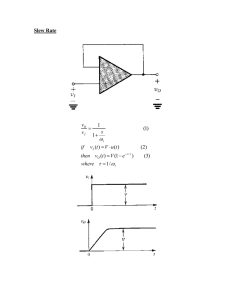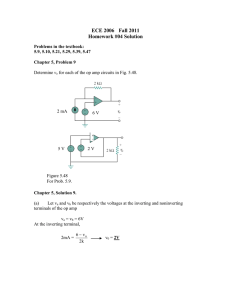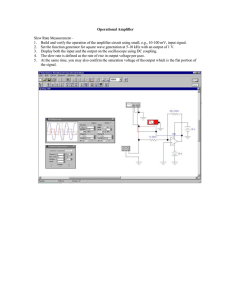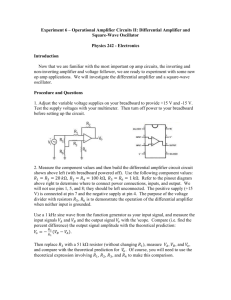Lecture 13 - KFUPM Open Courseware
advertisement
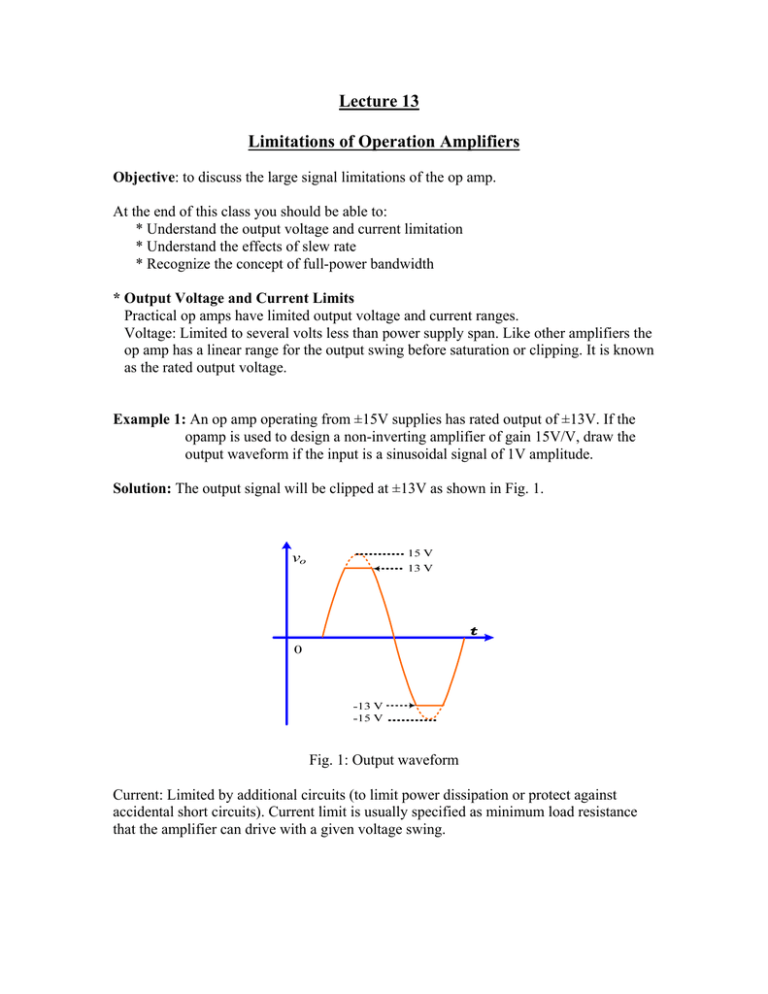
Lecture 13 Limitations of Operation Amplifiers Objective: to discuss the large signal limitations of the op amp. At the end of this class you should be able to: * Understand the output voltage and current limitation * Understand the effects of slew rate * Recognize the concept of full-power bandwidth * Output Voltage and Current Limits Practical op amps have limited output voltage and current ranges. Voltage: Limited to several volts less than power supply span. Like other amplifiers the op amp has a linear range for the output swing before saturation or clipping. It is known as the rated output voltage. Example 1: An op amp operating from ±15V supplies has rated output of ±13V. If the opamp is used to design a non-inverting amplifier of gain 15V/V, draw the output waveform if the input is a sinusoidal signal of 1V amplitude. Solution: The output signal will be clipped at ±13V as shown in Fig. 1. Fig. 1: Output waveform Current: Limited by additional circuits (to limit power dissipation or protect against accidental short circuits). Current limit is usually specified as minimum load resistance that the amplifier can drive with a given voltage swing. Example 2: Find expression for the op amp output current for the non-inverting amplifier of Fig.2. vo io vs R2 i = 0A iF iL RL R1 Fig. 2: Non-inverting amplifier with load io = i L +i F = vo vo + R +R L 2 1 R = R (R + R ) L 1 2 EQ R = vo R EQ Note that for inverting amplifier, R =R R EQ L 2 Slew Rate: * The second important large signal limitation of the op amp is known as the slew rate. Slew rate (SR) is defined as the maximum rate of change of voltage at output of op amp dV SR = o unit (V / us ) dt max * Typical values are in the range from 0.1V/ms to 10V/ms. Slew rate is usually studied by considering the op amp connected as a voltage buffer Fig. 3(a). The closed loop gain of the buffer using op amp with finite gain bandwidth is given by: Vo 1 = Vi 1 + s / ωt or Vo (t ) = V (1 − e −ωt t ) Thus, if the input is step function Fig. 3(b) the output will be exponentially rising waveform Fig. 3(c). This is only true if the amplitude of the input is small. However, for large step input the output will be ramp as shown in Fig. (d). This is because the op amp output is unable to increase at required rate and the op amp is said to be “slewing”. In fact, the op amp will operate to supply its maximum output current. Fig. 3: Slew Rate * Slew rate phenomenon not only causes distortion in large output signal but also in sinusoidal waveforms. Assume the input to the buffer is a sine wave input given by: Vi = A sin(ωt ) ⇒ dVi = ωA cos(ωt ) dt dVi dt at zero cros sings = ωA max The rate of change of this signal is which has maximum value of at zero crossings. Therefore, if ω tV ≤ SR , the output will be distorted as shown in Fig. 4. Fig. 4: Effect of slew rate on sinusoidal signals Example 3: Consider a voltage buffer realized by an op amp exhibiting a slew rate of 1V/us and unity gain bandwidth fT of 1 MHz. Find the largest input such that the output waveform will still be exponential ramp. Solution: the op amp will not slew as long as ω tV ≤ SR V= SR ωt = 1 10 × 2π × 1 × 10 6 −6 = 0.16V Full-power bandwidth: Another important term related to slew rate is known as full-power bandwidth. It is usually given in op amp data sheets. It is defined as the maximum frequency (fM)at which a full-scale signal (maximum possible output VM) can be processed without slewing. The relationship between SR and fM can be developed as follows: V ω ≤ SR M SR ∴V ≤ M ω f M ≤ SR 2πV FS For given frequency, slew rate limits maximum signal amplitude that can be amplified without distortion. Frequency at which an output sinusoid with maximum amplitude (Vomax) slews SR ω M Vo max = SR ⇒ f M = 2πVo max For a gain frequency ( ω ) To avoid distortion Vo ≤ Vo max ( ωM ) ω Example 4: An op amp has a rated output voltage of plus minus 10 and a slew rate of 1V/us. Calculate the op amp full-power bandwidth. Solution: f M ≤ SR 1 = =15.9kHz − 6 2πV FS 10 × 2π ×10
